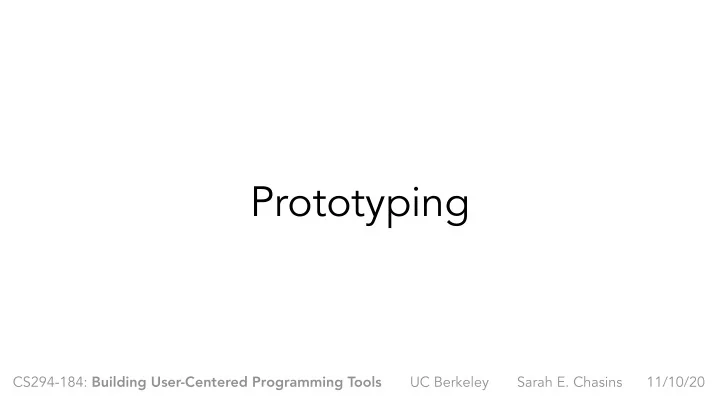

Prototyping CS294-184: Building User-Centered Programming Tools UC Berkeley Sarah E. Chasins 11/10/20
Plan for today • A quick pass through takeaways from the reading • Dig in on this weeks prototyping + design critique activity!
Prototyping “…users can't tell you what they want, but when they see something and get to use it, they soon know what they don't want.” Interaction Design: Beyond Human - Computer Interaction by Yvonne Rogers et al.
Prototype Roles • Make you think harder, plan more thoroughly about what you want to build • Help you solicit feedback on the thing you plan to build
Low- vs. High-Fidelity Prototypes
https://blog.adobe.com/en/publish/2017/11/29/prototyping-difference-low-fidelity-high-fidelity-prototypes-use.html#gs.l1tk0k
https://blog.adobe.com/en/publish/2017/11/29/prototyping-difference-low-fidelity-high-fidelity-prototypes-use.html#gs.l1tk0k
Interactable, higher-fidelity https://blog.adobe.com/en/publish/2017/11/29/prototyping-difference-low-fidelity-high-fidelity-prototypes-use.html#gs.l1tk0k
Low-Fidelity Prototypes • Claims you may hear about low-fi prototypes: • People love to give you feedback on font size and if your icons make sense to them • If you don’t want that kind of feedback, if you want feedback on elements deeper than aesthetics, consider low-fidelity prototypes • Also if it looks like you drew it in crayon and didn’t sink a lot of time into it, people are more willing to criticize, which is what you want • Personally haven’t found research-backed evidence of the above • (Send me your references!) • But …lots of evidence that you get just as much/just as good feedback from low-fi, and they’re faster and cheaper to make, faster to tweak and change
Low-Fidelity Prototypes • But …lots of evidence that you get just as much/just as good feedback from low-fi, and they’re faster and cheaper to make • …with the result that maybe you’re more willing to criticize yourself and to throw things away when you realize they’re not right
A nice resource on the case for low-fi prototypes • With good arguments for the claims mentioned on prior slides
Wizard-of-Oz Prototyping • Like what we did the very first day of class! • Lets us get around engineering effort by having a human do the work that our tool will eventually automate • Human can be: • Compiler, interpreter • Program synthesizer • Programming environment • Program transformation tool • …
We’ve talked about lo-fi… • …because for today’s purposes, we’re mostly interested in early-stage formative studies • But of course we want to be getting feedback from users at all points! • Calling it low-fidelity naturally suggests the existence of high-fidelity…
Interaction Design: Beyond Human - Computer Interaction by Yvonne Rogers et al.
Let’s do some prototyping! • In-class prototyping and design critique activity: • https://docs.google.com/document/d/ 1vWzZWg8l_kOexNltuEDX0-K1m8DeqnuveSLKzCc6Eqc/ edit
Recommend
More recommend